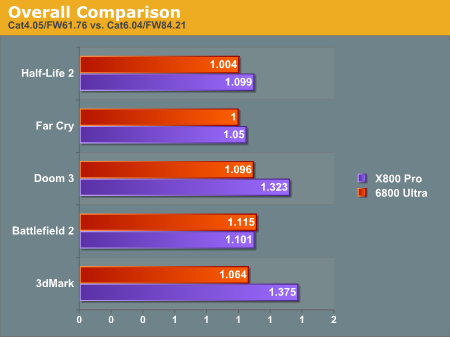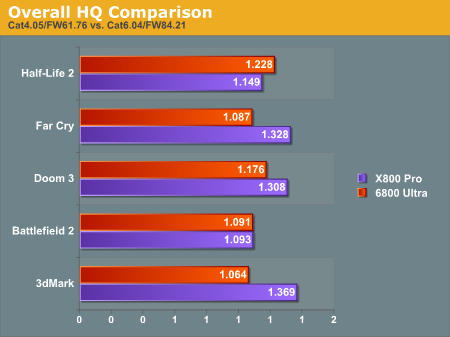Looking Back Pt. 3: The 6800 Ultra, ForceWare, and the Future
by Ryan Smith on May 11, 2006 4:00 AM EST- Posted in
- GPUs
NV40 vs. R420
Now that we have gone through NVIDIA's efforts on a per-driver level, we finally have a chance to answer the burning question of the moment of where NVIDIA's overall driver-based performance improvement compare to ATI's. As we noted previously, ATI gave us some impressive results with the 6800 series' competitor, the X800 series, and even better numbers on the aging 9700 Pro.With a brand new architecture, the expectation is that NVIDIA will have more headroom within the NV40 to improve performance, while ATI will have already tapped out much of the R420's headroom since it's a derivative design. NVIDIA also has the reputation of being the more dynamic of the duo with their drivers, so let's see how things go.
As with before, the following is a performance summary, using a performance factor between the first and latest drivers on our selected games to normalize against the innate differences between the X800 Pro and 6800 Ultra. For the NVIDIA drivers, we have started with the 61.76 instead of the 60.72 drivers, since the latter had problems with all of the selected games.

With AA/AF disabled, it doesn't come as a surprise that neither the X800 Pro nor 6800 Ultra post extremely large performance gains except for 3DMark, where we have previously seen ATI optimizing heavily for it. Doom 3 does stand out as the only game that posts even a moderate performance improvement with these advanced features off, favoring the X800 Pro and ATI's traditionally weaker OpenGL performance in this case. Battlefield 2 also shows a minor 10-12% improvement, with a slight edge to the 6800U. Overall then the X800 Pro does a bit better than the 6800 Ultra in total performance improvements, but it's not a very significant difference outside of Doom3.

Looking at the performance difference between the two cards with AA/AF enabled, and the results are surprising to say the least. Once again we see ATI's massive performance improvements for 3DMark05 showing up, once and for all settling the question of who optimized for 3DMark more in this previous generation. Turning to the games, we see ATI further open the gap between itself and NVIDIA in Far Cry, with a 33% to 8% performance improvement on a game that ATI already leads.
Half-Life 2 and Doom 3 basically offset each other, with each side taking a win. As we mentioned previously, Half-Life 2 is a title where ATI has had a natural lead, so to see such an effort by NVIDIA is to be expected, though in terms of raw performance it has been a large gap to close at times. Similarly, ATI benefits the most under Doom 3, adding 28% versus NVIDIA's 18%. Finally, neither side manages to add more than approximately 8% to their Battlefield 2 scores, showcasing just how graphically punishing the game is among everything tested here, but also a bit surprising in that neither side has found a good way to boost their scores yet. BF2 also requires quite a bit of CPU processing power, and the pixel shader effects definitely put a strain on the GPU core - this can be seen by the slightly higher improvements seen under the "basic" settings as opposed to the advanced mode.
Overall then, there is a trend worth noting, however counterintuitive it is. While we have said that it is NVIDIA that traditionally makes the most of its drivers, this was clearly not the case with the previous generation. Whether it's a testament to what the Catalyst team can do versus the ForceWare team, a hardware generational difference, or both, when both the normal and high quality tests are factored in, ATI is the victor for getting the most out of its drivers.










24 Comments
View All Comments
Schugy - Thursday, May 11, 2006 - link
nVIDIA has done quite a good job with linux drivers. It's simple to run this script and start your favourite game afterwards. nVIDIA's reward will be that I`ll buy a GF7800GT for AGP when it comes out. I wonder why the last anandtech linux story is more than 10 months old.KickusAssius - Sunday, May 14, 2006 - link
I have owned the 9000, 9500 PRO and 9700 PRO and I just hate ATI's drivers. I had problems with at least half of the games I played. Gradually they fixed certain problems, but other problems were never resolved even after contacting ATI directly via email and I was not the only one.Prior to this, I owned a Geforce 256 and Geforce 4 MX and Nvidia's drivers were nothing spectacular, but they always worked.
Now, I have owned the 6800GT, and the 7800GTX and the drivers have been excellent for a long time now. The only problems I ever had were in CSS, but Nvidia fixed that problem relatively quickly. Also, I have never had a system crash as a result of Nvidia drivers, but several times this happened with my 9700 PRO, (still loved the card though especially when drivers got better). I think that now both sides have excellent drivers, though ATI's control panel is simply annoying.
johnsonx - Thursday, May 11, 2006 - link
The image for Doom3 with the 60.72 driver can't be right; in the text you say there are major rendering issues with th 60.72 driver, but both images (normal and 'moused-over') look fine to me; the image presented as the 60.72 image looks identical to the 61.76 image presented below it.ozzimark - Thursday, May 11, 2006 - link
the pictures are too small for me to really even see anythingjohnsonx - Thursday, May 11, 2006 - link
oh, nevermind, i see it nowJarredWalton - Thursday, May 11, 2006 - link
The rendering error isn't "major" -- that's why we kept the 60.72 results in the graph. You could certainly play the game with the 60.72 drivers and never realized there was a "problem". For anyone else trying to find the anomaly, look for the vertical lines right in the center of the screenshot.synque - Thursday, May 11, 2006 - link
I think the conclusion the article draws is completely meaningless. Nothing can be said about NVIDIA because they either failed to improve the drivers, or the drivers were close to "optimal" from the start.One could speculate that the ATI drivers weren't optimal because they could be improved. But even that'd be guessing, because the driver team most likely optimizes for popular games after they are released (which could lead to special optimizations).
So I know exactly as much as I knew before reading the article. Weird.
z3R0C00L - Thursday, May 11, 2006 - link
Umm not true,You forget that the x8x0 line are essentially built on an improved R300 design. They're not an all new part. This means ATi have gradually worked to improve there drivers. They were optimal to begin with since they're essentially the same driver SDK that reaches to the time of the 9700 Pro.
I have a feeling that if a 9800 Pro were tested you'd see the same improvements in non video card bottlenecked situations.
This proves that the Catalyst driver team is superior to the Forceware driver team. But most of us have known this since Catalyst 3.0. Heck even Microsoft has stated this as well as 3rd party driver analysts. ATi's card have less issues then nVIDIA cards and carry with them less issues not fixed from previous releases. There's a simple way of checking this.. read the Driver Release notes from both ATi and nVIDIA.. you'll notice FAR more unresolved issues with nVIDIA drivers then ATi drivers. Many of them major issues.
One thing nVIDIA is better at, and this is a fact, is supporting older hardware (GeForce2,3,4). ATi's 8500 support is lackluster at best. I can't remember the last time a driver release focused on fixing issues that still exist since Catalyst 3.0 on the 8500 series.
Redofrac - Thursday, May 11, 2006 - link
Since Catalyst 3.0? I'm going to have to disagree with that.From firsthand experience owning a 9700 Pro with the earlier catalysts, I have to say that they were crap. Having to try multiple releases of the driver to find one that was actually stable isn't quite what I'd use for the mark of a good driver team. Every once in a while they'd manage to get out a stable release, and I'd stick with that one until the next, lest random games start crashing on me or glitching.
I can't speak for ATI's current drivers, which I'll assume are much better (dealing with drivers for a 9700 somewhat turned me away from ATI) but I find it a bit hard to say that 3.0 drivers were stable with a straight face.
LoneWolf15 - Friday, May 12, 2006 - link
And I owned a Radeon 9700(non-pro) and had no problems at all; in fact, I'd daresay it's the best card I've ever owned in terms of performance/stability/longevity. But, one experience does not equal all.I'm not debating your experience, but what if you had a borderline power supply at the time, for example? That could easily cause some issues.
Neither of us is a representative example of how the Radeon 95xx/97xx cards worked by ourselves. By and large though, the enthusiast community had very few issues with this series of cards.